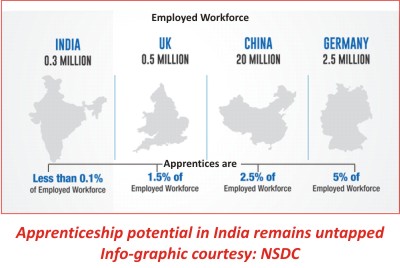|
New Reforms make Stronger
Grounds Our country has the youngest workforce in the world with 64% of its population falling under the working age bracket. Countries like US, South Korea, Japan, China and those in Western Europe have been in our situation. Youth vigour helped them to grow rich, as they invested in education and skills, health, empowerment and employment. Inspired from this ‘demographic dividend’ i.e. having a higher young labour force, the Indian government has recently carried out certain amendments in the already existing Apprentices Act, 1961, which was enacted with the objective of regulating the programme of training of apprentices in the industry by utilising the facilities available therein for imparting on-the-job training. The National Policy of Skill Development and Entrepreneurship 2015, focuses on apprenticeship as one of the key programmes for creating skilled manpower in India. This policy proposes to pro-actively work with industry including MSME sector to facilitate a tenfold increase in apprenticeship opportunities in the country by 2020. Wider Reach As a means to digitise this in September 2015, the Government launched the National Web Portal for Apprenticeship Training (National Portal) to facilitate the movement of processes under the Apprentices Act to an online forum, which can also be looked upon as a step to ensure wider reach. With this new portal or amendment, the government also tried to break the rigid approach of only on boarding apprentices in engineering trades or designated trades i.e. for the trades which are notified. Now under this new apprenticeship promotion policy or scheme, optional trades which includes skill sets utilised under service sector are also taken care of. With inclusion of service sectors, variety of non-technical job roles automatically fall under the purview of apprenticeship promotion. Also making it mandatory for employers to have certain number of apprentices as a part of their workforce ensures sustainability and sets the tone right for the future.
More Inclusive With both designated and optional trades included in apprenticeship scheme, it has opened vistas for a wider reach. As per this recent development, even a 10th pass can look for apprenticeship. This policy states Apprenticeship Training as one of the most efficient solutions to develop skilled manpower for industry by using training facilities available in the establishments without putting any extra burden on exchequer to set up training infrastructure i.e. the reason why in this recent amendment there are provisions of employer co-created courses. Through these courses only those demand-based courses or skills are promoted to ensure sure shot absorption of apprentices by the industry. There is also an attempt to include the employers in the basic training of apprentices. Tapping the Untapped This new amendment looks like to be inspired from the first world countries where apprenticeship is promoted as a route to enter the job market. Till 2015-16, as per National Apprenticeship Promotion Scheme guidelines, only 2.30 lakh trade apprentices were undergoing apprenticeship training in 30,165 establishments throughout the country under the Apprentices Act, 1961 which is miniscule as compared to the total number of establishments in the country. In 2015-16 there were about 50 lakh employees in Central Public Sector Undertaking, Central Government and Banking Sector. If these establishments would have engaged apprentices even up to the mandatory minimum limit of 2.5% of the total manpower strength, the number could have reached 1,25,000. According to the fifth economic census, there are 20,62,124 MSMEs having 6 or more workers. If each establishment engages even one apprentice, the number could be 20 lakh. Unfortunately, due to lack of participation from employers and lack of awareness about apprenticeship despite having training facilities and the potential manpower the connect between both demand and supply was missing. Probably with this new thrust on apprenticeship in government’s policy on skilling quality on the job training would be provided to ensure that we have worthy and able workforce contributing towards economic and social growth. ■
Jyoti Sharma
References: |
